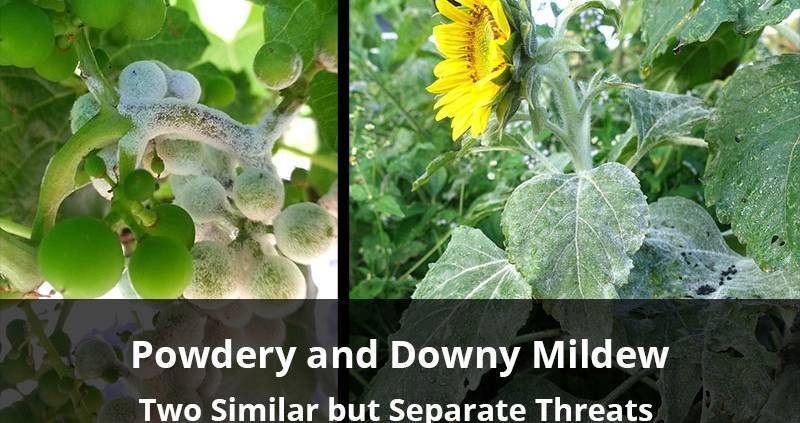Powdery and downy mildews are two common pathogens that impact plant and crop health. Powdery mildew is a fungus that results in distinct white spots on plant leaves and stems. It’s common among many plants and crops including legumes, cucurbits, apples, pears, onions, maple trees, and grapes. It requires low humidity with warm temperatures, making greenhouses a great environment to infect. On the other hand, downy mildew is a fungus-like parasite that is actually more closely related to algae. It also results in spots which are distinct in that they are more angular, and often yellow or gray in color. In grapes, downy mildew spots are yellow and oily-looking. In mint and basil, downy mildew spots are darker brown or black. Downy mildew is most common in spring and fall with cool nights and high humidity, warm days.
With both mildews, they survive by stealing nutrients from plants which can stress, weaken and even kill the plant. They can also make plants vulnerable to other pathogens and insect damage. Similarly, they can spread via insects like aphids, wind, rain, runoff, irrigation, and contact with infected plants.
Downy mildew is a zoospore, making it capable of “swimming” through water to infect one plant to the next. Spots on leaves can grow larger and denser until they even impact photosynthesis. This can lead to defoliation, sunburn, soft rots, plant death, and can affect the level of sugars that develop in fruit and vegetables and therefore their flavor. Both also have unique varieties that affect particular crops, for example the variety of powdery mildew that has infected squash cannot infect grapes. It is important to be aware of plant families though, as mildew that has attacked basil can be transferred to mint.
Despite their differences, their management techniques are similar. Because they need high humidity to proliferate, it’s best to avoid over-watering techniques, avoid fertilization during outbreaks, properly space plants particularly in greenhouses, and prune overcrowded areas particularly for trees and crops like grapes. Since downy mildew can overwinter, it is critical to dispose all infected plants. For cucurbits, there are some mildew-resistant crop strains. For grapes, berries will naturally protect themselves after 2-3 weeks of their development. However, certain fungicides like sterol inhibitors and strobilurins don’t completely kill mildew and others like difenoconazole are phytotoxic to grapes.
For grapes in particular, and any other affected plant or crop, there are environmentally friendly fungicides and algaecides that can contain both powdery and downy mildew. BioSafe PerCarb is a biofungicide based in sodium carbonate peroxyhydrate that should be applied every 7-10 days to field crops or within greenhouses. To maximize treatment efficiency, it is recommended to supplement with a foliar treatment such as Oxidate 2.0. These fungicides work together to provide increased stability, and again can be applied from seed to harvest via spray, soil drench, or pre-plant drip with a 0-hour re-entry interval and 0-day pre-harvest interval. They are also both EPA certified, OMRI approved, and biodegradable.



Leave a Reply
Want to join the discussion?Feel free to contribute!